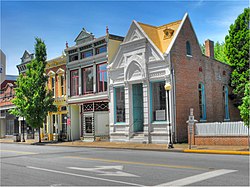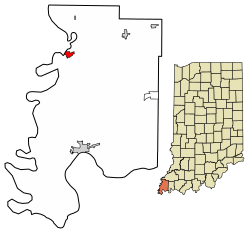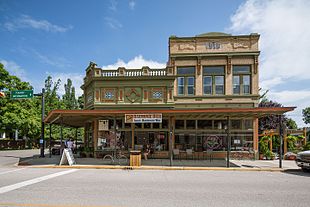
Back نيو هارموني Arabic بلده نيو هارمونى ARZ New Harmony (Indiana) Catalan Нью-Гармони (Индиана) CE New Harmony (lungsod sa Tinipong Bansa, Indiana) CEB Nová Harmonie Czech New Harmony (Indiana) German New Harmony Esperanto New Harmony (Indiana) Spanish New Harmony (Indiana) Basque
New Harmony, Indiana | |
|---|---|
Town | |
 Downtown New Harmony | |
 Location of New Harmony in Posey County, Indiana. | |
| Coordinates: 38°7′44″N 87°55′49″W / 38.12889°N 87.93028°W[1] | |
| Country | United States |
| State | Indiana |
| County | Posey |
| Township | Harmony |
| Area | |
• Total | 0.82 sq mi (2.13 km2) |
| • Land | 0.81 sq mi (2.11 km2) |
| • Water | 0.01 sq mi (0.02 km2) |
| Elevation | 377 ft (115 m) |
| Population | |
• Total | 690 |
| • Density | 923.93/sq mi (356.82/km2) |
| Time zone | UTC-6 (CST) |
| • Summer (DST) | UTC-5 (CDT) |
| ZIP code | 47631 |
| Area code | 812 |
| FIPS code | 18-52974[4] |
| GNIS feature ID | 2396802[1] |
| Website | http://www.newharmony-in.gov |
New Harmony is a historic town on the Wabash River in Harmony Township, Posey County, Indiana.[1] It lies 15 miles (24 km) north of Mount Vernon, the county seat, and is part of the Evansville metropolitan area. The town's population was 690 at the 2020 census.
Established by the Harmony Society in 1814 under the leadership of George Rapp,[5] the town was originally known as Harmony (also called Harmonie, or New Harmony).[5] In its early years the 20,000-acre (8,100 ha) settlement was the home of Lutherans who had separated from the official church in the Duchy of Württemberg and immigrated to the United States.[6] The Harmonists built a new town in the wilderness, but in 1824 they decided to sell their property and return to Pennsylvania.[7] Robert Owen, a Welsh industrialist and social reformer, purchased the town in 1825 with the intention of creating a new utopian community and renamed it New Harmony. The Owenite social experiment failed two years after it began.[8]
New Harmony changed American education and scientific research. Town residents established the first public library, a civic drama club, and a public school system open to men and women. Its prominent citizens included Owen's sons: Robert Dale Owen, an Indiana congressman and social reformer who sponsored legislation to create the Smithsonian Institution; David Dale Owen, a noted state and federal geologist; William Owen, a New Harmony businessman; and Richard Owen,[5] Indiana state geologist, Indiana University professor, and first president of Purdue University. The town also served as the second headquarters of the U.S. Geological Survey. Numerous scientists and educators contributed to New Harmony's intellectual community, including William Maclure, Marie Louise Duclos Fretageot, Thomas Say, Charles-Alexandre Lesueur, Joseph Neef, Frances Wright, and others.
Many of the town's old Harmonist buildings have been restored. These structures, along with others related to the Owenite community, are included in the New Harmony Historic District. Contemporary additions to the town include the Roofless Church and Atheneum.[8] The New Harmony State Memorial is located south of town on State Road 69 in Harmonie State Park.

- ^ a b c d U.S. Geological Survey Geographic Names Information System: New Harmony, Indiana
- ^ "2019 U.S. Gazetteer Files". United States Census Bureau. Retrieved July 16, 2020.
- ^ Cite error: The named reference
wwwcensusgovwas invoked but never defined (see the help page). - ^ "U.S. Census website". United States Census Bureau. Retrieved January 31, 2008.
- ^ a b c Chisholm, Hugh, ed. (1911). . Encyclopædia Britannica. Vol. 19 (11th ed.). Cambridge University Press. p. 498.
- ^ Donald Pitzer (2012). New Harmony Then and Now. 601 North Morton Street: Quarry Books. pp. 16–17. ISBN 978-0-253-35645-1.
{{cite book}}: CS1 maint: location (link) - ^ Karl J. R. Arndt, A Documentary History of the Indiana Decade of the Harmony Society, 1814–1824 (Indianapolis: Indiana Historical Society, 1975) 1:xi.
- ^ a b Ray E. Boomhower, "New Harmony: Home to Indiana's Communal Societies," Traces of Indiana and Midwestern History 14(4):36–37.